Pet Operations and Hospitalisation

Our normal experience for pets admitted to the Veterinary Centre for routine surgery is as follows:
Stage 1
Patients are normally admitted by one of our nurses in the morning between 8.30 and 9.30am. They check the patient’s general fitness for surgery including their weight, and talk to the owner regarding expected timing of their pet’s procedure. The nurse then takes the patient to our warm kennels or cattery, and places them in a suitable comfy bed. We always have pheromone diffusers on in our pet accommodation, to promote relaxation and a calm atmosphere.
Stage 2
Patients are then brought from the kennels/cattery to our preparation area and any pre operative blood testing, placing of catheters for intravenous fluids, and pre-operative sedation may be undertaken at this point, the patients are then returned to their bed to relax and to ensure the pre op sedation takes effect. This pre op usually contains a sedative and a strong form of pain relief. This reduces the amount of injectable anaesthetic required and ensures stable anaesthesia.
Stage 3
We normally start with what we consider to be clean ops i.e. those that involve going into an abdomen, and then progress to other operations such as lump removals. Dental treatments are always undertaken last due to the bacterial load within the patient’s mouth. The patient is brought back through to prep and placed onto our prep table, where a patch of fur is clipped off their front leg to allow visualisation of the vein we will use to administer the intravenous anaesthetic.
Stage 4
We introduce a carefully calculated dose of injectable anaesthetic which renders the patient unconscious and enables us to introduce an endotracheal tube into the patient’s windpipe. This is then used to supply both oxygen and gaseous anaesthetic, to keep the patient anaesthetised during their operation. Occasionally, we will also use nitrous oxide gas during the anaesthetic for its additional pain reliving qualities. Our aim is to produce a balanced anaesthetic with a combination of drugs and techniques. We also start using our multi-parameter monitor to check various patient parameters such as heart rate, oxygen inspired, and carbon dioxide expired. This monitor will be used during the whole of the procedure but more importantly one of our highly trained nurses is dedicated to your pets care during this crucial time.
Stage 5
Our patient is now transferred into theatre, and placed on our heated and padded operating table for its surgical procedure. Keeping our patients comfortable and warm helps them to recover speedily from the anaesthetic. Our theatre is a separate very clean space, just used for surgical procedures and contains everything we will need during the operation such as our radiosurgery machine.
Stage 6
After the anaesthetic, patients are transported back to their bed, which is kept especially warm to ensure a fast recovery from the anaesthetic. A nurse stays with recovering patients to monitor their recovery.
At this time we usually try to contact the patient’s owners, with news of the operation and when they should phone back for and update on their pets progress and for a collection time later in the day. Most patients are ready to return home between 4.30pm and 6.30pm that day. Occasionally, patients will stay with us over night to recover, however the vast majority of patients go home the same day.
Stage 7
After recovery, our patients are offered water and a small amount of a suitable recovery diet. We appreciate that they have been starved overnight and that they may be quite hungry. Feeding before they go home allows us to ensure they are recovering well from their anaesthetic and supplies nutrition for maintenance and healing. Our canine patients are taken outside for a chance to go to the toilet. Our feline patients are offered litter trays.
Stage 8
Finally 15 minute appointment is made with one of our nurses to discharge the patient, discuss any post operative requirements, and answer any questions about the patient’s treatment. A written copy of the discharge instructions are also given as a reminder, together with the remaining postoperative recovery diet if any is left!
An appointment may be made also with Zoe to discuss the operation itself or explain and radiographs or other diagnostic tests that may have been undertaken.
